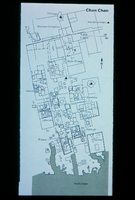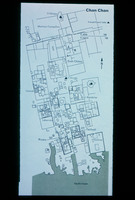| dc.description | great ruined and abandoned city, the capital of the Chimú kingdom (c. AD 1100–1470) and the largest city in pre-Columbian America. It is situated on the northern coast of present-day Peru, about 300 miles (480 km) north of Lima in the Moche valley, between the Pacific Ocean and the city of Trujillo. Chan Chan was designated a UNESCO World Heritage Site in 1986.
The ruins of Chan Chan, which cover nearly 14 square miles (36 square km), are in fairly good condition because the area is usually rainless. The building material used was adobe brick, and the buildings were finished with mud frequently adorned with patterned relief arabesques. The centre of the city consists of several walled citadels, or quadrangles. Each of these contains pyramidal temples, cemeteries, gardens, reservoirs, and symmetrically arranged rooms. These quadrangles presumably were the living quarters, burial places, and storehouses of the aristocracy. Most of the city's population—artisans and farmers—lived outside the quadrangles in modest quarters of less-durable construction.
Ruled from Chan Chan, the Chimú kingdom was for two centuries the chief state in Peru. It extended approximately from Piura in the north to Paramonga in the south. Its economy was based on agriculture, which in that dry region was supported by irrigation ditches. The Chimú seem to have elaborated a system of social-class stratification. Craftsmen produced fine textiles and gold, silver, and copper objects; a polished blade pottery was mold-made and produced according to standardized designs.
As successors to the Moche civilization, the Chimú spoke Yunca (Yunga, or Moche), a now-extinct language, but had no writing system. Between 1465 and 1470 they came under Inca rule, apparently persuaded that Inca arms were invincible. Chimú historical and mythological traditions were recorded by Spanish writers after the conquest (c. 1532).
Encyclopedia Britannica | en_US |



